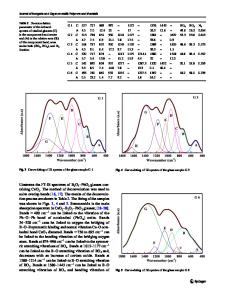Ta 2 O 5 -doped zinc-borate glasses: physical, structural, optical, thermal, and radiation shielding properties
- PDF / 5,443,789 Bytes
- 16 Pages / 595.276 x 790.866 pts Page_size
- 60 Downloads / 350 Views
Ta2O5‑doped zinc‑borate glasses: physical, structural, optical, thermal, and radiation shielding properties Sertac Ozturk1 · Erkan Ilik2 · Gokhan Kilic2 · U. Gokhan Issever2 Received: 3 August 2020 / Accepted: 30 September 2020 © Springer-Verlag GmbH Germany, part of Springer Nature 2020
Abstract In this study, examination of the physical, structural, optical and thermal properties of the glasses with the glass composition (100 − x)(0.6ZnO·0.4B2O3)·xTa2O5 (0, 1, 2, 3, 4 mol%) was aimed. Physical properties of the glasses synthesized with the classical melt-quenching method were calculated; density and molar volume values of the synthesized glasses based on the doping quantity were calculated. FTIR spectra were used in order to determine the structural properties in doped glasses. During the optical examinations of the synthesized glasses, direct and indirect optical band gap values were obtained with the help of Tauc plot method, and Urbach energies were calculated. Glass transition temperatures, melting temperatures, crystallization temperatures, and thermal stabilities were determined with DSC analysis. The main purpose of this study is to synthesize high-density glasses by adding higher-density T a2O5 instead of relatively low-density chemicals (ZnO and B2O3) and to examine the radiation shielding properties of these glasses. Therefore, the effect of T a2O5 doping on gamma and neutron radiation shielding properties was investigated using Geant 4 Monte Carlo toolkit. It was observed that T a 2O 5 doping increased radiation shielding properties significantly. Especially, the increase in gamma radiation shielding properties was determined to be more compared to the increase in neutron radiation shielding properties. Keywords Zinc-borate glasses · Ta2O5-doped glasses · FTIR · Urbach energy · Radiation shielding
1 Introduction Amorphous glasses which have peerless properties have been preferred in many fields of technology [1]. As a basic glass former, boron-doped glasses make triangle bond with oxygen with the help of B3+ ions and form glass networks. The cooling rate of the compounds melted in boron-doped glass samples is also an important factor due to affect the structure of the borate glasses [2]. It is also known that this structure varies depending on the concentration of the added composition and that boroxol rings, pentaborate, tetraborate and diborate groups can be formed [3, 4]. Borate glasses are frequently used in scientific researches and in technology due to their low melting temperatures, high permeability and high thermal stability in the UV and IR regions [5, 6]. * Sertac Ozturk [email protected] 1
Department of Physics, Faculty of Science and Letters, Tokat Gaziosmanpasa University, Tokat, Turkey
Department of Physics, Faculty of Science and Letters, Eskisehir Osmangazi University, TR‑26040 Eskisehir, Turkey
2
The synthesized structures are named as fluorite, oxyfluoride and borophosphate glasses. For example, because of the high neutron absorption cross section of iro
Data Loading...











